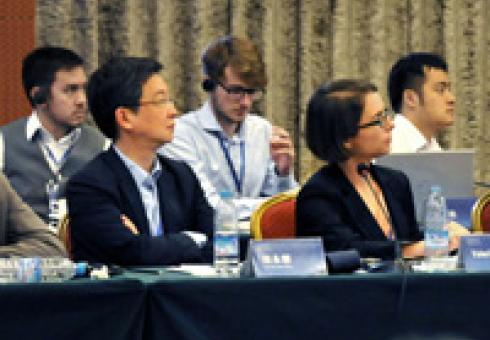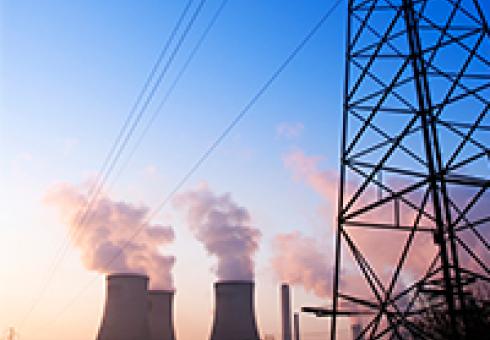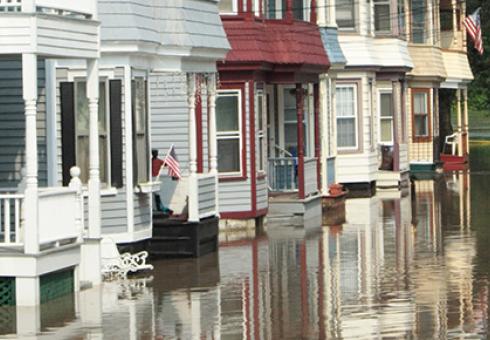News + Media
Kerry Emanuel at MIT EAPS Tech Day 2014. Assessing the current understanding of the major climate processes and proposing new directions for climate research.
Human life has been so remarkably successful that its sustainability has become the major challenge of our age. Meeting energy needs in a sustainable fashion will require not only bringing together investors, corporations, scientists, and policy makers but new ways of thinking. Can economics be the catalyst in this?
New research examines regulations to cut carbon emissions and finds benefits to cap and trade system.
Evan Lehman
E&E reporter
It turns out that cap and trade might not be so bad after all.
New research shows that reducing carbon emissions through regulations like the administration's recent rules on power plants cuts less carbon at a higher price than the embattled climate policy Congress failed to pass in 2010. Cap and trade, or an equivalent carbon tax, would be economically easier on families, fairer to lower-income people and more flexible for emitters, according to a study by the Massachusetts Institute of Technology.
The study does not specifically examine U.S. EPA's newly proposed carbon rules, but it aims at the ballpark of all proposed rules. As such, it looks at regulatory options to cut carbon in the electricity sector, like a national renewable electricity standard and a clean energy standard, which permits nuclear power and natural gas. It also tested transportation regulations that already exist -- a fuel economy standard for new cars.
And it found that none of them works very well.
A renewable electricity standard and a transportation fuel economy standard would result in one-quarter of the emissions cuts attained by a cap-and-trade system. And all three would cost about the same, they said.
"Put differently, an equivalent level of emissions reduction could be achieved under a cap-and-trade system for less than 5% of the cost of either regulatory policy," said the researchers at the MIT Joint Program on the Science and Policy of Global Change.
If both regulatory plans were enacted -- one on electricity and the other on transportation -- their combined cost would be more expensive than a cap-and-trade system, the report says. But they would reduce just half the amount of emissions.
Take the transportation policy as an example. Increasing fuel efficiency only affects new cars, so carbon reductions can't be found in cheaper areas, like in agriculture or other industries, said Valerie Karplus, a research scientist with MIT and an author of the study.
"Any regulation that focuses on a subset of emissions reductions opportunities will therefore cost at least as much as an economy-wide cap-and-trade system, and often such targeted regulations actions can be much more costly," she said in an email.
Read more...
MIT researchers compare regulatory policies to a price on greenhouse gases and discover both the national and regional impacts.
MIT study finds that springtime ozone levels are good predictors of summertime temperatures in the Southern Hemisphere.
By Jennifer Chu
For the past two summers, Australians have sweated through record heat waves, with thermometers climbing as high as 118 degrees Fahrenheit in parts of the country. In January, officials were forced to halt tennis matches during the Australian Open due to extreme heat — a decision made following several days of sizzling temperatures.
Now MIT researchers have found that the intensity of summer temperatures in Australia and elsewhere in the Southern Hemisphere may be better predicted as early as the previous spring by an unlikely indicator: ozone.
From their study, published in the Journal of Climate, the scientists found that as the springtime ozone hole’s severity varies from year to year, the temperatures in Australia and southern regions of Africa and South America reveal correlations: Years with higher springtime ozone experience hotter summers, and vice versa.
The results suggest that ozone levels may help meteorologists predict the severity of summertime temperatures months in advance.
“No one has actually looked at the variation of ozone as a way to forecast or predict the climate or the next summer’s temperature,” says lead author Justin Bandoro, a graduate student in MIT’s Department of Earth, Atmospheric and Planetary Sciences. “This could be especially important for farmers, and for areas like southeastern Australia, where most of that nation’s population resides.”
Bandoro’s MIT co-authors include Susan Solomon, the Ellen Swallow Richards Professor of Atmospheric Chemistry and Climate Science, and postdoc Aaron Donohoe, as well as David Thompson of Colorado State University and Benjamin Santer of Lawrence Livermore National Laboratory.
A spring forecast for summer temperatures
In 1987, countries around the world signed the Montreal Protocol, an international treaty that established a global phase-out of chemicals that cause ozone depletion. Because of the long lifetime of the chemicals, the ozone hole will continue to occur for many years, but it is expected to slowly begin to become less severe in the next several decades.
Bandoro and his colleagues analyzed annual ozone measurements, from 1979 through the most recent heat wave in 2013.
The team combined data from various sources, including a station in Antarctica that has measured total ozone levels in the same atmospheric column since the 1950s. The team performed a correlation analysis to identify links between ozone levels and variables such as temperature, precipitation, and wind patterns.
Although the ozone hole won’t close for many years, its intensity does vary somewhat from one year to another, and the depth of the hole affects an atmospheric phenomenon known as the Southern Annular Mode, which describes the wind patterns that circle Antarctica and influence the strength and position of fronts and storm systems in the Southern Hemisphere.
In years with high springtime ozone, the researchers found that winds shifted, bringing hotter summer temperatures to much of Australia and parts of southern Africa and South America. Lower ozone levels reversed this behavior, with winds leading to cooler summertime temperatures to these same regions.
Expect more extreme temperatures as ozone hole recovers
The link between springtime ozone and summertime temperatures is particularly strong for the present period, while ozone is still in a recovery phase. When the researchers examined this link from a period before the ozone hole had begun to form, they observed a much weaker correlation.
The implication, Bandoro says, is that as ozone levels likely rise in the coming decades, these parts of the Southern Hemisphere will probably experience systematically hotter summers.
“We can expect that these types of summers are going to be more frequent as the ozone hole recovers in coming decades,” Bandoro says. “When the ozone hole is deep, it essentially holds back climate change from showing its face, and Australia is just starting to feel this effect in the summertime in years with shallower ozone holes.”
David Karoly, a professor of earth sciences at the University of Melbourne, says the MIT group has shown, for the first time, a strong relationship between the severity of summer temperatures in Australia and the strength of the ozone hole the previous spring. The results, he says, point to a long-term warming trend in the Southern Hemisphere.
“As the ozone hole recovers this century, the masking effects of ozone depletion causing reduced summer warming over the Southern Hemisphere will disappear,” says Karoly, who did not participate in the study. “Then there will be an acceleration of the summer warming trends over Australia and South Africa, as the ozone hole recovers and the masking influence disappears.”
New analysis of cyclones shows migration away from tropics and toward the poles in recent decades.
by Peter Dizikes
Powerful, destructive tropical cyclones are now reaching their peak intensity farther from the equator and closer to the poles, according to a new study co-authored by an MIT scientist.
The results of the study, published today in the journal Nature, show that over the last 30 years, tropical cyclones — also known as hurricanes or typhoons — are moving poleward at a rate of about 33 miles per decade in the Northern Hemisphere and 38 miles per decade in the Southern Hemisphere.
“The absolute value of the latitudes at which these storms reach their maximum intensity seems to be increasing over time, in most places,” says Kerry Emanuel, an MIT professor and co-author of the new paper. “The trend is statistically significant at a pretty high level.”
And while the scientists who conducted the study are still investigating the atmospheric mechanisms behind this change, the trend seems consistent with a warming climate.
“It may mean the thermodynamically favorable conditions for these storms are migrating poleward,” adds Emanuel, the Cecil and Ida Green Professor of Earth and Planetary Sciences at MIT.
The implications are serious, since the movement of peak intensity means regions further north and south of the equator, which have not previously had to face many landfalls by violent cyclones, may now have greater exposure to these extreme weather events. That, in turn, could lead to “potentially profound consequences to life and property,” the paper states. “Any related changes to positions where storms make landfall will have obvious effects on coastal residents and infrastructure.”
Moving with the trade winds?
The paper, “The Poleward Migration of the Location of Tropical Cyclone Maximum Intensity,” was co-written by James P. Kossin — who is the lead author — of the National Oceanic and Atmospheric Administration's National Climatic Data Center; Gabriel A. Vecchi of the National Oceanic and Atmospheric Administration; and Emanuel.
To conduct the study, the scientists used international data from 1982 to 2012, collected by NOAA’s National Climatic Data Center. They used the location of peak intensity of cyclones as a benchmark because it is a more consistent metric than statistics such as storm duration: The duration can be harder to estimate because of difficulties in establishing precisely when a storm should first be considered a tropical cyclone.
While there are regional differences in the poleward movement of cyclones, the fact that every ocean basin other than the northern Indian Ocean has experienced this change leads the researchers to suggest, in the paper, that this “migration away from the tropics is a global phenomenon.”
However, Emanuel notes, the global mechanisms underlying the trend are a matter for further research.
“We think, but have not yet been able to establish, that this is connected to independently observed poleward expansion of the Hadley circulation,” Emanuel says, referring to a large-scale pattern of global winds, which in recent years has also moved further poleward. The paper notes the potential impact of vertical wind shear, which inhibits cyclone formation; data suggests a decrease in wind shear in the tropics and an increase at higher latitudes.
Emanuel notes that researchers in the field are continuing to examine the links between storm migration and global warming. Over the past three decades, the incidence of cyclones in the tropics has actually diminished — because while tropical cyclones may become more intense in a warmer climate, it is actually more difficult to generate them.
Ocean temperatures between 82 and 86 degrees Fahrenheit seem to be “ideal for the genesis of tropical cyclones,” Emanuel says, “and as that belt migrates poleward, which surely it must as the whole ocean warms, the tropical cyclone genesis regions might just move with it. But we have more work to do to nail it down.”
Michael Mann, a professor of meteorology and director of the Earth System Science Center at Penn State University, says the matter of cyclone migration is “a very interesting new angle on the larger issue of how climate change may be impacting tropical cyclone activity.”
Overall, Mann adds, “The findings seem quite plausible. We know that human-caused climate change is leading to a poleward shift in certain features of the atmospheric circulation. … It would be surprising if these shifts were not influencing tropical cyclones. This study shows that they are, by causing a poleward migration in the zones where atmospheric shear is either favorable or prohibitive to tropical cyclone formation.” In practical terms, he says, the result may have “considerable implications” for coastal cities in the long term.



